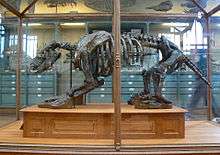Scelidotheriinae
| Scelidotheriinae | |
|---|---|
 | |
| Scelidotherium leptocephalum in Paris | |
| Scientific classification | |
| Kingdom: | Animalia |
| Phylum: | Chordata |
| Class: | Mammalia |
| Subclass: | Theria |
| Infraclass: | Eutheria |
| Superorder: | Xenarthra |
| Order: | Pilosa |
| Suborder: | Folivora (partim) |
| Family: | †Mylodontidae |
| Subfamily: | †Scelidotheriinae (Ameghino 1889) Gaudin 1995 |
| Genera | |
|
See text | |
Scelidotheriinae is a subfamily of extinct ground sloths within the order Pilosa, suborder Folivora and family Mylodontidae, related to the other extinct mylodontid subfamilies, Lestodontinae and Mylodontinae. The only extant families of the suborder Folivora are Bradypodidae and Megalonychidae. Erected as the family Scelidotheriidae by Ameghino in 1889, the taxon was demoted to a subfamily by Gaudin in 1995.[1][2]
Taxonomy
Together with the rest of Mylodontidae and the engimatic Pseudoprepotherium, the scelidotheriines form the superfamily Mylodontoidea. Chubutherium is an ancestral and very plesiomorphic member of this subfamily and does not belong to the main group of closely related genera.
Subfamily †Scelidotheriinae (Ameghino 1889) Gaudin 1995
- Genus †Analcitherium
- Genus †Catonyx
- Genus †Chubutherium (basal)
- Genus †Elassotherium
- Genus †Nematherium
- Genus †Neonematherium
- Genus †Proscelidodon
- Genus †Scelidotheriops
- Genus †Scelidotherium
- Genus †Sybillotherium
- Genus †Valgipes
References
- ↑ PaleoBiology Database: Scelidotheriinae, basic info
- ↑ Gaudin, T. J. (1995-09-14). "The Ear Region of Edentates and the Phylogeny of the Tardigrada (Mammalia, Xenarthra)". Journal of Vertebrate Paleontology. 15 (3): 672–705. doi:10.1080/02724634.1995.10011255. JSTOR 4523658.
Further reading
- Cuvier, G. (1796): Notice sur le squellette d'une très grande espèce de quadrupède inconnue jusqu'à présent, trouvé au Paraquay, et déposé au cabinet d'histoire naturelle de Madrid. Magasin encyopédique, ou Journal des Sciences, des Lettres et des Arts (1): 303-310; (2): 227-228.
- Iuliis, G.; Cartelle, C. (December 1999). "A new giant megatheriine ground sloth (Mammalia: Xenarthra: Megatheriidae) from the late Blancan to early Irvingtonian of Florida". Zoological Journal of the Linnean Society. 1 27 (4): 495–515. doi:10.1006/zjls.1998.0190.
- Harrington, C.R. (1993): Yukon Beringia Interpretive Center - Jefferson's Ground Sloth. Retrieved 2008-JAN-24.
- Hogan, C.M. (2008): Cueva del Milodon, Megalithic Portal. Retrieved 2008-APR-13
- Kurtén, B.; Anderson, E. (1980). Pleistocene Mammals of North America. Columbia University Press. ISBN 978-0-231-03733-4. OCLC 776120509.
- McKenna, M. C.; Bell, S. K. (1997). Classification of Mammals: Above the Species Level. Columbia University Press. ISBN 978-0-231-52853-5. OCLC 182575570.
- Nowak, R.M. (1999): Walker's Mammals of the World (Vol. 2). Johns Hopkins University Press, London.
- White, J. (1993). "Indicators of locomotor habits in xenarthrans: Evidence for locomotor heterogeneity among fossil sloths". Journal of Vertebrate Paleontology. 13 (2): 230–242. doi:10.1080/02724634.1993.10011502.
- White, J. L.; MacPhee, R. D. E. (27 June 2001). "The sloths of the West Indies: a systematic and phylogenetic review". In Woods, C. A.; Sergile, F. E. Biogeography of the West Indies: Patterns and Perspectives (2nd ed.). CRC Press. pp. 201–235. ISBN 978-1-4200-3948-1. OCLC 46240352.
- Woodward, A. S. (January 1900). "On some Remains of Grypotherium (Neomylodori) listai and associated Mammals from a Cavern near Consuelo Cove, Last Hope Inlet, Patagonia". Proceedings of the Zoological Society of London. 69 (1): 64–78. doi:10.1111/j.1096-3642.1890.tb01704.x.
External links
| Wikimedia Commons has media related to Ground Sloth. |